8 Ways to Improve Your Production Score (2025)
The Production subscore is perhaps the most important one because many schools and universities have a required minimum Production subscore. In addition, many students find Production challenging because it measures writing and speaking, the two hardest aspects of any language.
In this blog post, we’re going to look at some simple tips and tricks that will boost your score immediately. By the end, you’re going to be completely familiar with every Production question. Most importantly, you’ll know exactly how to do well on each one.
Let’s jump in!
Table of Contents
- Understand the Production Subscore
- How Duolingo Scores Production
- Top 8 Tips for Production Questions
- Production Questions on the Duolingo English Test
- Conclusion

Understand the Production Subscore
The Production subscore is 1 of the 4 subscores on the Duolingo English Test (DET), so it counts for 25% of your overall score.
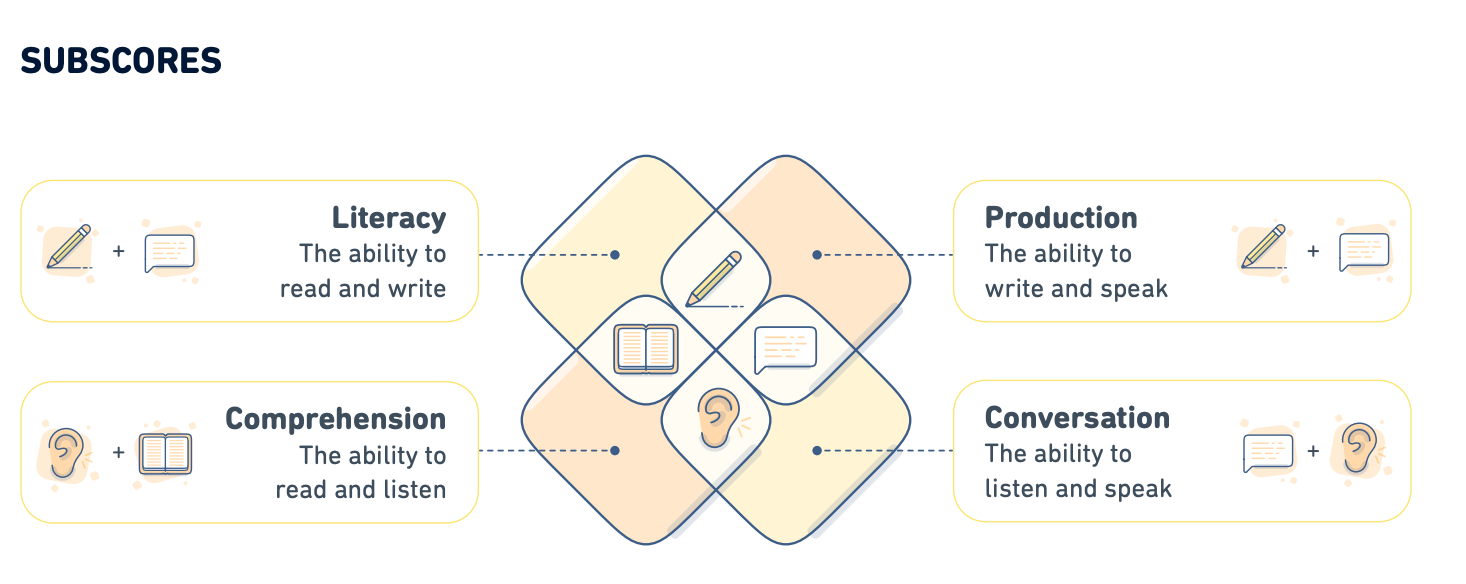
But what does “Production” mean exactly? Duolingo defines it as: “The ability to write and speak.” In other words, it’s your ability to produce English, through both writing and speaking.
👉 Do you also want to improve your Conversation subscore? Check out our article: 6 Ways to Improve Your Conversation Score
How Duolingo Scores Production
In April 2024, Duolingo changed the way they evaluate writing and speaking questions. Below are the new scoring criteria.
- Content: Relevance, style, development, and effect on the reader
- Discourse coherence: Clarity, cohesion, progression of ideas, and structure
- Lexis (vocabulary): Lexical diversity, lexical sophistication, choice of words, formation of words, and spelling
- Grammar: Grammatical complexity, grammatical accuracy, and punctuation
- Fluency: Speed, natural use of pauses, and reliance on filler words, repetition, and starting/stopping
- Pronunciation: Intelligibility, individual sounds, word stress, sentence stress, and intonation
Criteria 3 through 6 are all straightforward. But, the first two – "content and "discourse coherence" – are not as clear. These two criteria look at the ideas in your response. In short, Duolingo is looking for whether your ideas are easy to follow. Do you present a clear point of view? Do you provide clear supporting ideas? Is it easy to understand how one idea connects to the next?
Top 8 Tips for Production Questions
We also have these tips in a YouTube video!
1. Have a strategy for each type of question
Production questions are the hardest because you have to figure out what to talk about. But you also have to make sure that you don’t make grammar mistakes. That’s a lot to do in a very short time!
Having a strategy for each question type is helpful because it allows you to come up with what you’re going to talk about. This frees up your mind to focus on choosing the right words and avoiding grammar mistakes while you’re writing or speaking. You can’t memorize responses, but you absolutely should memorize the strategy for each question type. (When we look at each question type below, I will give you a specific strategy for each one.)
2. Focus on grammar
Making simple grammar mistakes will lose you the most points. But, these mistakes are also the easiest to fix!
Before spending a lot of time trying to learn advanced vocabulary and advanced grammatical structures, make sure that you consistently use correct grammar.
3. But also make sure you write enough
"Length" used to be an explicit part of the scoring criteria. This is no longer the case, but Duolingo still cares about the length of your response.
In 2023, Duolingo stopped specifying a word minimum for responses. This means that it isn’t obvious how much you should produce. Based on the experience of our students, here is what we recommend at Arno.
- Write About the Photo => Minimum 30, over 50 if you need 130+
- Interactive Writing (Part 1) => Minimum 120, over 150 if you need 130+
- Interactive Writing (Part 2) => Minimum 90, over 100 if you need 130+
- Writing Sample => Minimum 120, over 150 if you need 130+
- Summarize the Conversation => Minimum 40, over 50 if you need 130+
If you write less than, Duolingo may deduct points from your response.
4. Vary your sentence structure
This helps with "Lexis" and "Grammar."
You need to be sure that not all of your sentences are “simple sentences.” Simple sentences start with the subject and the verb. For example:
- I like dogs.
- My school is far.
- My favorite team won the championship.
The best way to use fewer simple sentences is to use connecting words. These are words that connect one idea to another and naturally result in more complex sentences. Here are examples.
- And: I like football, and I like basketball.
- But: I like football, but I don’t like handball.
- So: I want to be healthy, so I run every morning.
- Yet: The test was difficult, yet I passed.
- However: We want to go for a walk. However, it is raining.
- Which: We are getting pizza for dinner, which is my favorite food.
- Because: I’m tired because I hiked a mountain yesterday.
- Therefore: I didn’t sleep last night. Therefore, I’m tired today.
- Moreover: I like going to the gym because it makes me feel healthy. Moreover, I see many friends there.
- In fact: I love my house. In fact, it’s my favorite place in the world.
- For example: There are many ways to raise your DET score. For example, you can make sure you have a plan for each question.
- First, second, third: I prefer the beach to the mountains. First, the beach is warmer. Second, it never snows at the beach. Third, the beach is closer to my house.
- In addition to: Cooking at home helps you eat more healthily, in addition to saving your money.
It’s important that you understand how to use these connecting words correctly. Otherwise, your writing will get worse, not better.
We recommend finding the translation of connecting words in your first language. This will enable you to immediately know how to use each one. With that knowledge, it’s just a matter of practicing with them so that you can use them confidently in the test.

5. Use synonyms
This helps you do better for the criterion “Lexis."
An easy way to use a greater diversity of words is to spot words that you use a lot and find different words that have a similar meaning. It’s best if you understand the subtle differences between words; using exactly the right word is a strong indicator of your English skills.
Below is a list of words that are often overused and some of their synonyms.
Good
- Great: Stronger than “good”
- Terrific: Stronger than “great”
- Tasty: Use “tasty” instead of “good” when describing food
- Enjoyable: Use “enjoyable” instead of “good” when describing an experience or place
Bad
- Terrible: Stronger than “bad”
- Miserable: Stronger than “terrible”
- Unpleasant: Use “unpleasant” instead of “bad” when describing an experience
Important
- Noteworthy: Use “noteworthy” to describe a detail or person worth knowing about
- Prominent: Use “prominent” to describe a person, company, or some entity that is well-known or powerful
- Crucial, essential, critical: These all convey the idea that something is necessary
Like
- Love: Stronger than “like”
- Adore: Stronger than “love”
- Enjoy: Use “enjoy” to describe food, places, or experiences
Small
- Tiny: Smaller than “small”
- Insignificant: Use “insignificant” to describe something that doesn’t matter
Large
- Huge: Larger than “large”
- Enormous: Larger than “large”
- Sizable: An almost direct synonym for “large”
Arno's free Vocabulary Builder is an excellent way to expand your vocabulary. To start, you should take our quick Vocabulary Assessment to determine your current level and find your weaknesses.
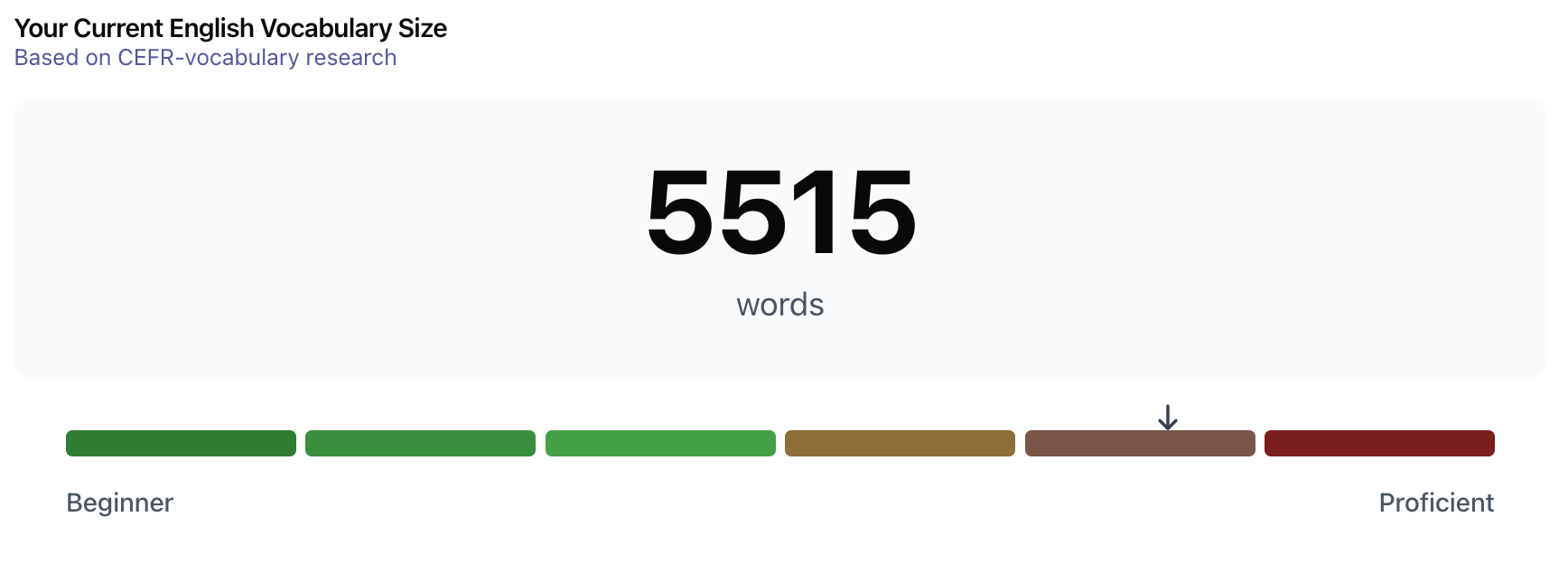

6. For writing questions, save time to review your response
You should think of writing and editing as 2 separate processes.
While you are writing, you are getting your ideas out. While you are editing, you are cleaning up your writing.
If you try to do both at the same time, you won’t do either well! On writing questions, for each minute, you should spend 50 seconds writing and 10 seconds editing.
For the Write About the Photo questions, you should spend 50 seconds writing and 10 seconds editing.
For the 5-minute Writing Sample and Interactive Writing (Part 1) questions, you should spend around 4 minutes writing and around 1 minute editing.
For Interactive Writing (Part 2), you should write for 2 minutes and 30 seconds and edit for 30 seconds.
For the 75-second Summarize the Conversation question, you should spend 1 minute writing 15 seconds editing.
While you are editing, look for typos and other obvious mistakes. Don’t get stuck trying to make one thing perfect. Focus on fixing the obvious, easy things.
7. For speaking questions, speak the entire time
In the speaking sections, there is no way to re-record your response or edit it. This is why most people dislike speaking questions the most!
A mistake that a lot of test takers make is that they don’t say enough. To avoid that, we recommend that you speak for the entire time. If you develop this habit as you prepare for the test, then you will also get more practice speaking.
If you think you won’t have enough to talk about, don’t worry. Once you master the strategies for these questions and you follow the final tip below, you’ll be fine 🙂
8. For speaking questions, slow down and enunciate
When you get stressed or nervous, you will naturally speak more quickly. You need to train yourself to slow down. This will allow you to really focus on pronouncing words well, which is called “enunciation” in English.
Slowing down also means that it’s easier to speak for the entire time!
Production Questions on the Duolingo English Test
Now we’re going to look more closely at the 7 kinds of Production questions that you will see in the test.
- Write About the Photo
- Speak About the Photo
- Interactive Writing
- Writing Sample
- Read, Then Speak
- Interactive Speaking
- Summarize the Conversation
- Speaking Sample
Write About the Photo
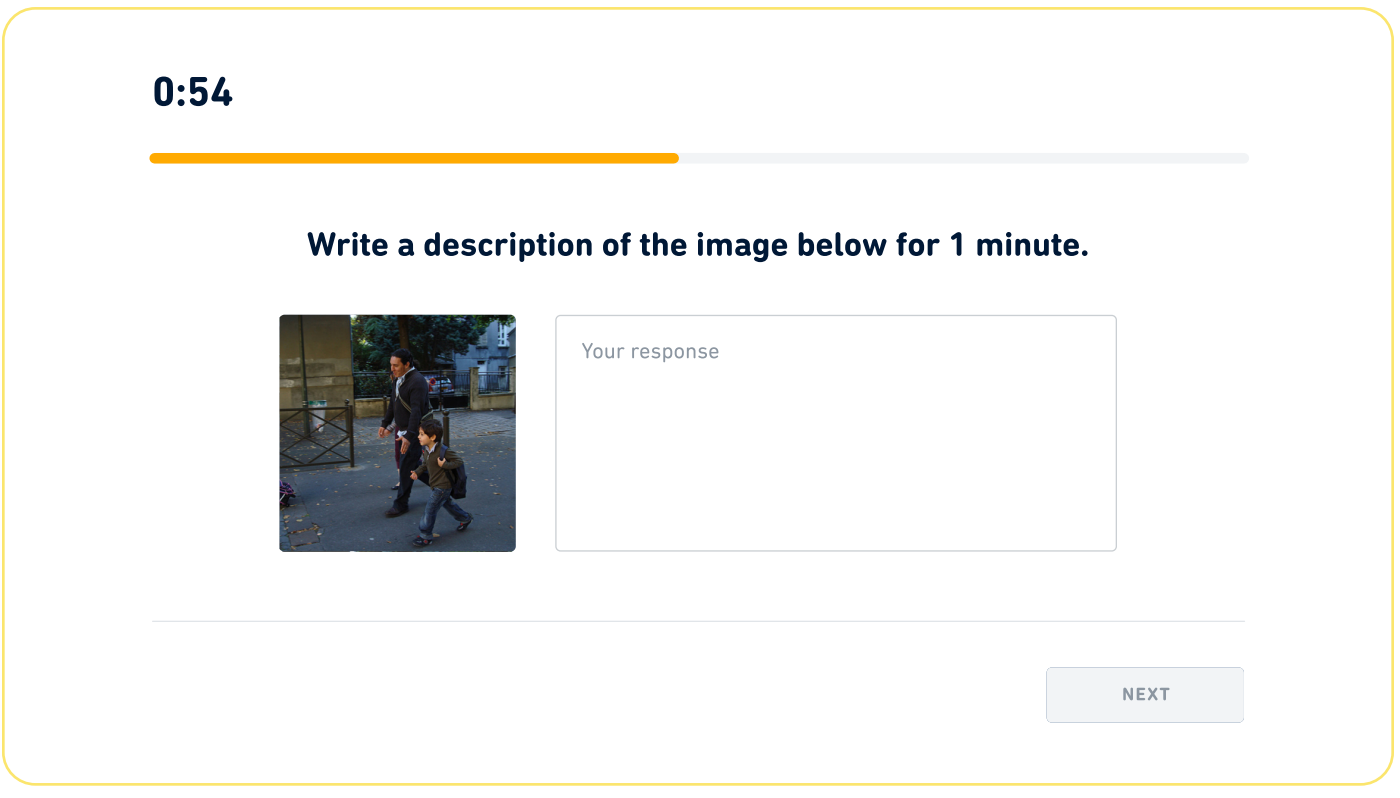
This question appears 3 times on the test.
You should aim to write at least 30 words but 50 is better.
To answer this question well, Duolingo recommends that you, “Try to describe the image as if explaining it to someone who can’t see it.” This is actually great advice. You should pretend like a friend is sitting across the room and you are describing to them the image.
The strategy we recommend for this question is: The 5 W’s: What, Who, Where, When, Why.
In your response, all you need to do is answer the following questions:
- What is happening in this photo?
- Who is doing what?
- Where are they doing it?
- When are they doing it?
- Why are they doing it?
For the image in the example above, here is an example response:

Two people are walking down the street and talking. One person is a man and the other is a boy. There is also a woman, but she isn’t with them. The man looks like the boy’s father. Both of them have bags, so maybe the boy is walking to school and the man is going to work. There are leaves on the ground and they are wearing sweaters, so it is likely autumn.
By answering each question, you can easily find things to talk about.
☝️ Remember! After 50 seconds, you should stop writing and spend the remaining 10 seconds editing.
Speak About the Photo
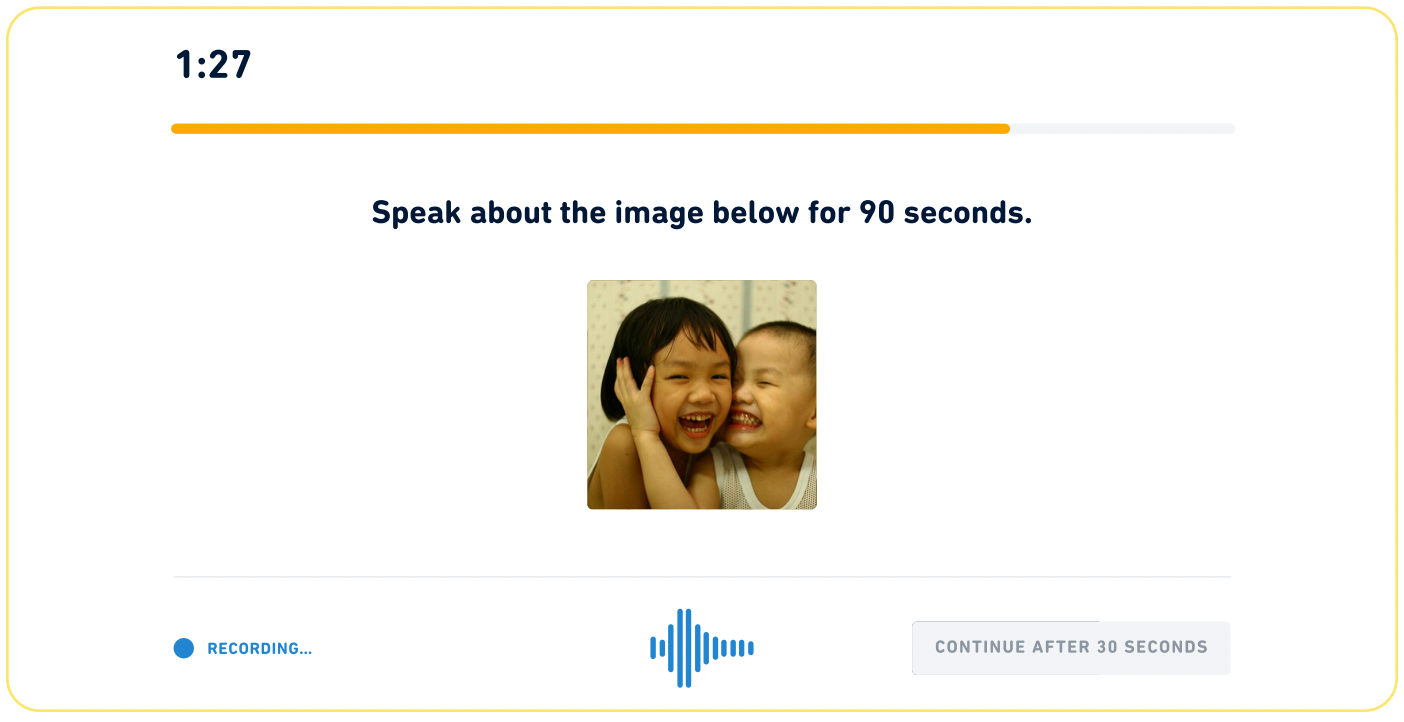
This question appears 1 time on the test.
You will have 20 seconds to look at the image and then 90 seconds to record yourself.
You can use those 20 seconds to go through The 5 W’s (⬆️) and figure out what you’re going to talk about.
You have a lot more time for this question than for Write About the Photo. Therefore, you should produce more words for this question. This means it is especially important to remember The 5 W’s.
Interactive Writing

This question appears 1 time on the test.
First, you will be a given a prompt and you will have 5 minutes to respond to it. Then, you will be a given a second prompt, and you will have 3 minutes to respond to this one. The second prompt will be related to the first.
For the first part, we recommend you write at least 120 words, but 150 is better. For the second part, aim to write at least 90 words, but 100 is ideal.
☝️ Remember! After about 3.5 minutes in part 1, you should stop writing and spend the remaining time editing what you have written. But if you have less than 120 words, then keep writing until you get to 120 and then start editing. In part 2, start editing at 2.5 minutes.
The strategy for this question is: I LAST
- Identify: Identify the topic
- List: List out the tasks Duolingo wants you to perform
- Answer: Answer the question or state your viewpoint directly
- Support: Support your answer
- Three: Provide two or three examples
We recommend spending 10 to 30 seconds thinking through I LAST and then starting to write. You will find it much easier to write once you know what you want to say. It is especially important that you carefully read the question and make sure you understand what you’re being asked to do. This sounds obvious, but during the exam, when you’re nervous and stressed, it is easy to read the prompt too quickly and misunderstand it!
Let’s use I LAST to respond to part 1 of the prompt above:
Freelance artists make a living independently selling their art and artistic skills rather than working for a company. What are some pros and cons of this career option? Include specific reasons in your answer.
- Topic ⇒ Freelance artists versus artists that work for a company
- Tasks ⇒ Duolingo wants us to:
- Discuss the pros of being a freelance artist
- Discuss the cons of being a freelance artist
- Include specific reasons
- Answer the question: “What are some pros and cons of this career option?”
- Support & two/three examples: Now, I need to defend my answer. This is best done by providing examples. Three examples is the perfect amount, but two is also fine.
It is best to answer the question as directly as possible. So, I begin my response with: "In my view, the biggest advantage of being a freelance artist is the independence." This has a strong effect on the reader, because they know exactly what I believe.
In the rest of the first paragraph, I elaborate on this independence enjoyed by freelance artists. I provide specific examples.
My two other paragraphs follow the same structure. I state my opinion clearly, then I support it with examples.
The I LAST strategy is effective because it makes sure that you directly address each part of the prompt, which will help with the "content" and "discourse coherence" criteria. It also helps you most effectively use your limited time when answering question. You can avoid wasting time writing things that won't help you score higher.
Writing Sample
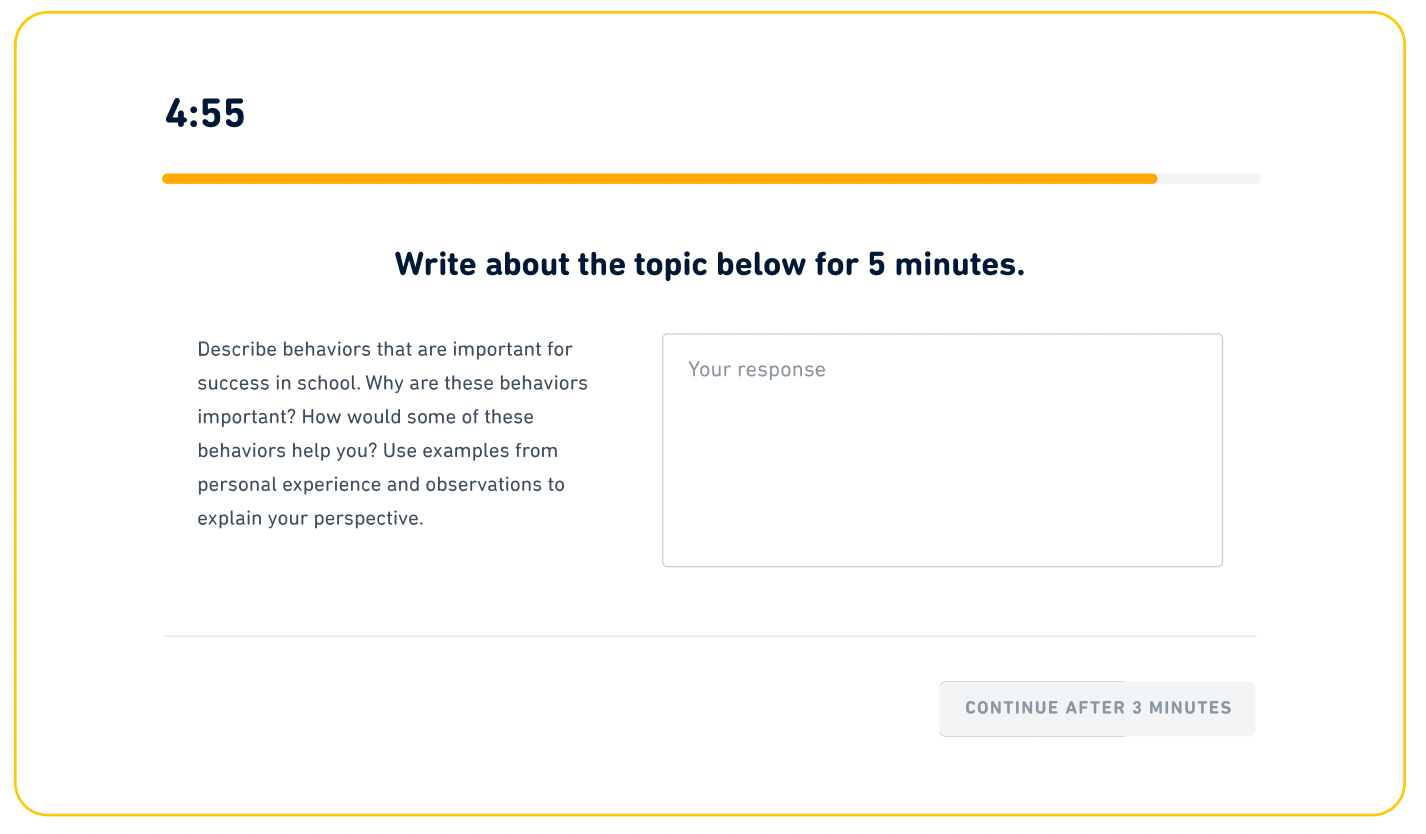
This question appears 1 time on the test.
For the Writing Sample, you will have 30 seconds to read the prompt and prepare your answer before the 5-minute timer begins. This makes the question a little easier.
Note that when you send your DET scores somewhere, your response to the Writing Sample is also sent. This is so that the recipients can see your writing for themselves. Don't worry – just focus on getting a good score and your writing will be strong 🙂
Your strategy for this question is also I LAST:
- Identify: Identify the topic
- List: List out the tasks Duolingo wants you to perform
- Answer: Answer the question or state your viewpoint directly
- Support: Support your answer
- Three: Provide two or three examples
👉 To see how to use this strategy, check out our other article: 10 High-Scoring Writing Samples
Read, Then Speak
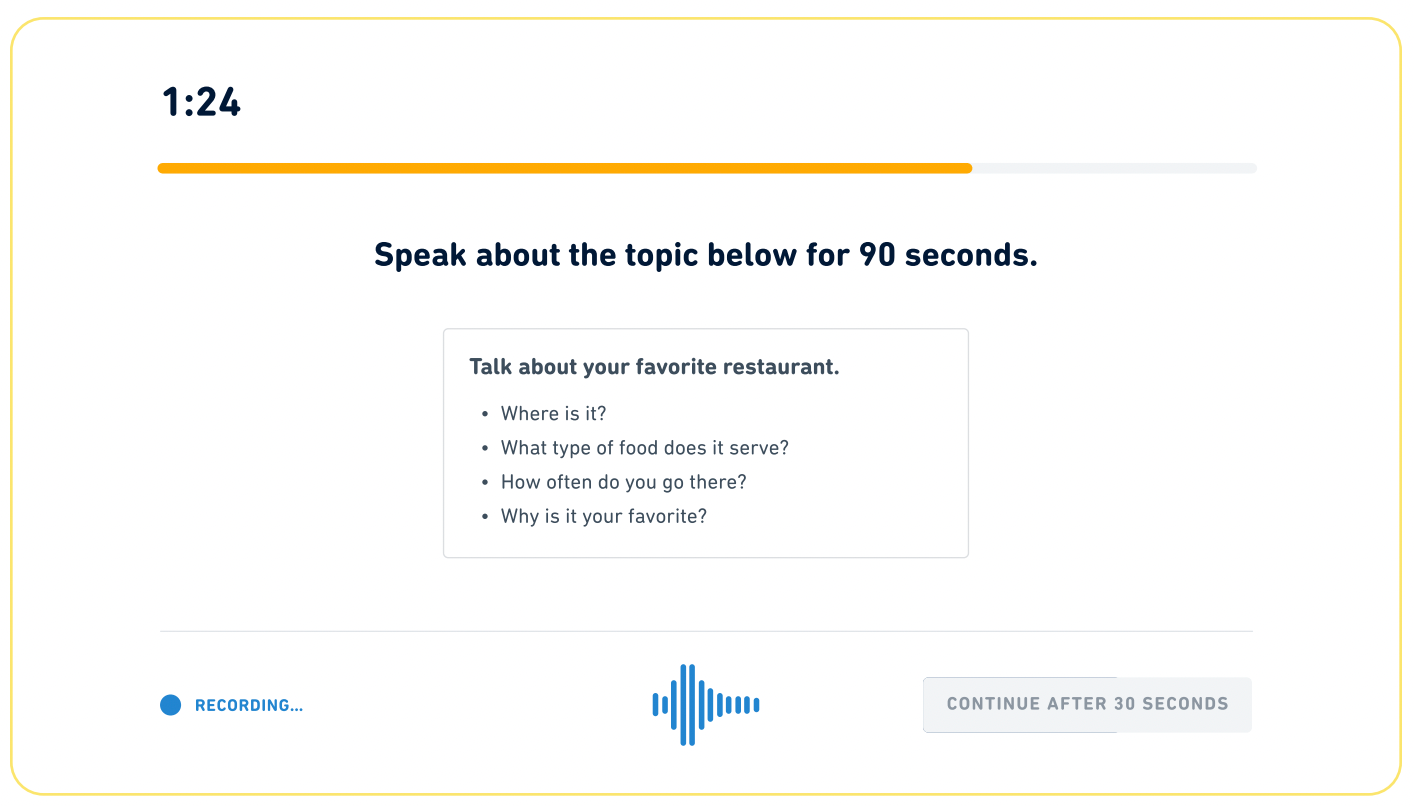
This question appears 1 time on the test.
You have 20 seconds to read the prompt and then 90 seconds to record your response. The prompt will be visible while you record yourself.
The strategy for this question is easy: Answer the Questions!
Duolingo provides you with specific instructions. All you have to do is and go down the list and answer each one.
☝️ Remember! Speak for the entire time. Slow down and enunciate.
Interactive Speaking
This question is similar to an interview. You will be asked 6 to 8 questions, which you have to listen to. You will then have 35 seconds to respond to each one.
This question appears 1 time on the test.
In your responses, you want to do 3 things:
- Answer the question as directly as possible. You only have 35 seconds, so you need to get right to the point.
- Explain why you think that. You need to provide reasons for your opinion.
- Give an example or specific details. This helps the grader understand your position and your reasons, making your response persuasive.
👉 For even more tips for Interactive Speaking, check out our masterclass, which you can find on our YouTube channel:
Summarize the Conversation
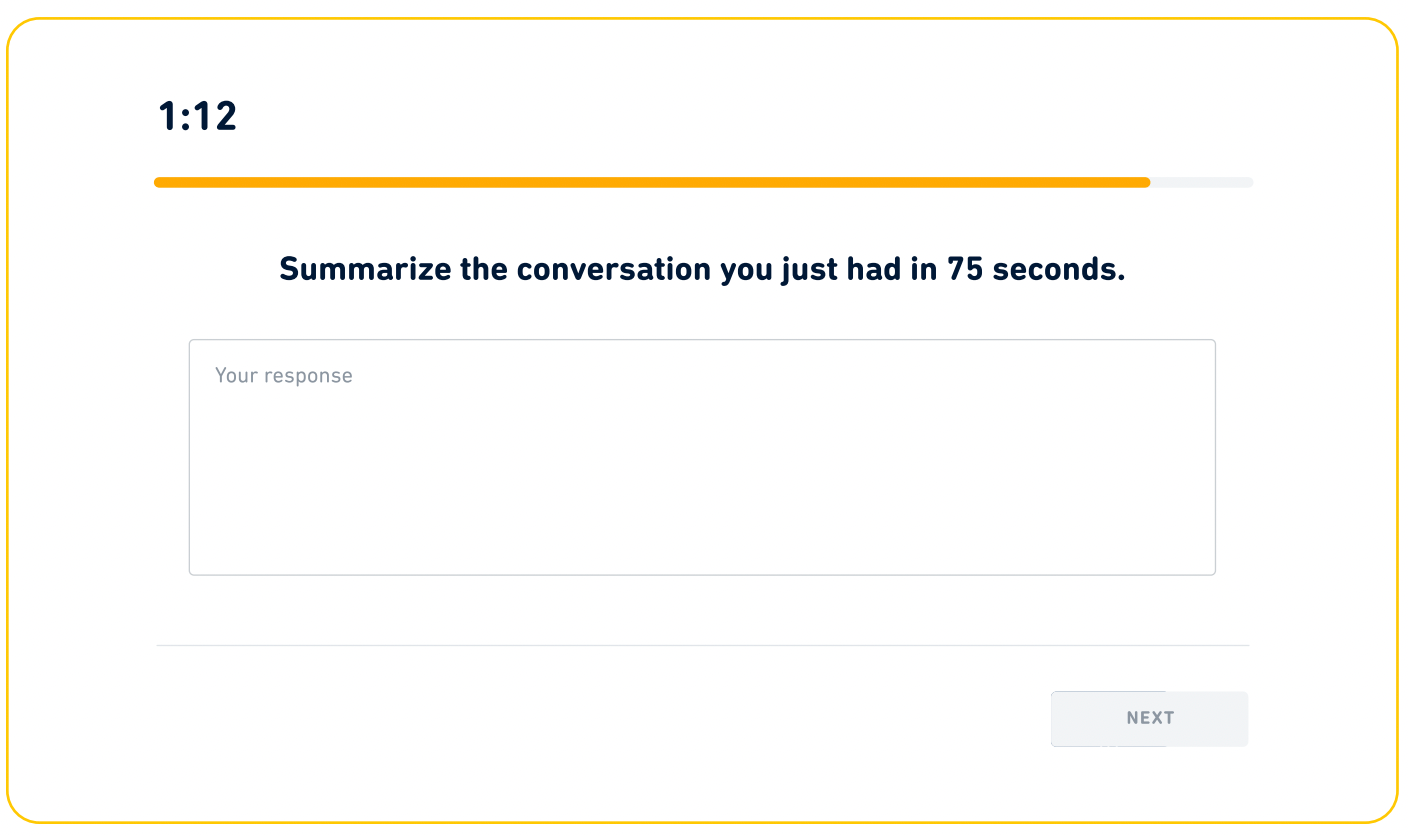
This question appears 1 time on the test.
You should aim to write 3 sentences, but 2 sentences is sufficient for a target score of 120 or below.
Summarize the Conversation comes after the Interactive Listening portions of the test. These portions simulate a conversation with another person.
In this question, you have 75 seconds to summarize that conversation.
For your summary, you should use our popular 3-sentence template. Briefly, the template looks like this:
- Sentence #1: I talked with ___ about ___.
- Sentence #2: The first new piece of information revealed in the conversation
- Sentence #3: The second new piece of information revealed in the conversation
For sentences #2 and #3, you should be sure to use some advanced vocabulary, which you can find in this PDF print out.
👉 For all the best tips and strategies on Summarize the Conversation, check out our full masterclass on this question type!
Conclusion
Now you are familiar with every Production question that you will see on the test. You know what you will be asked, how long you will have to respond, and you have strategies that will enable you to produce a great answer for every single one!
The best way to master the techniques you learned in this post is to practice them. That's why we built Arno 🙂 Just click the link below to get started!
